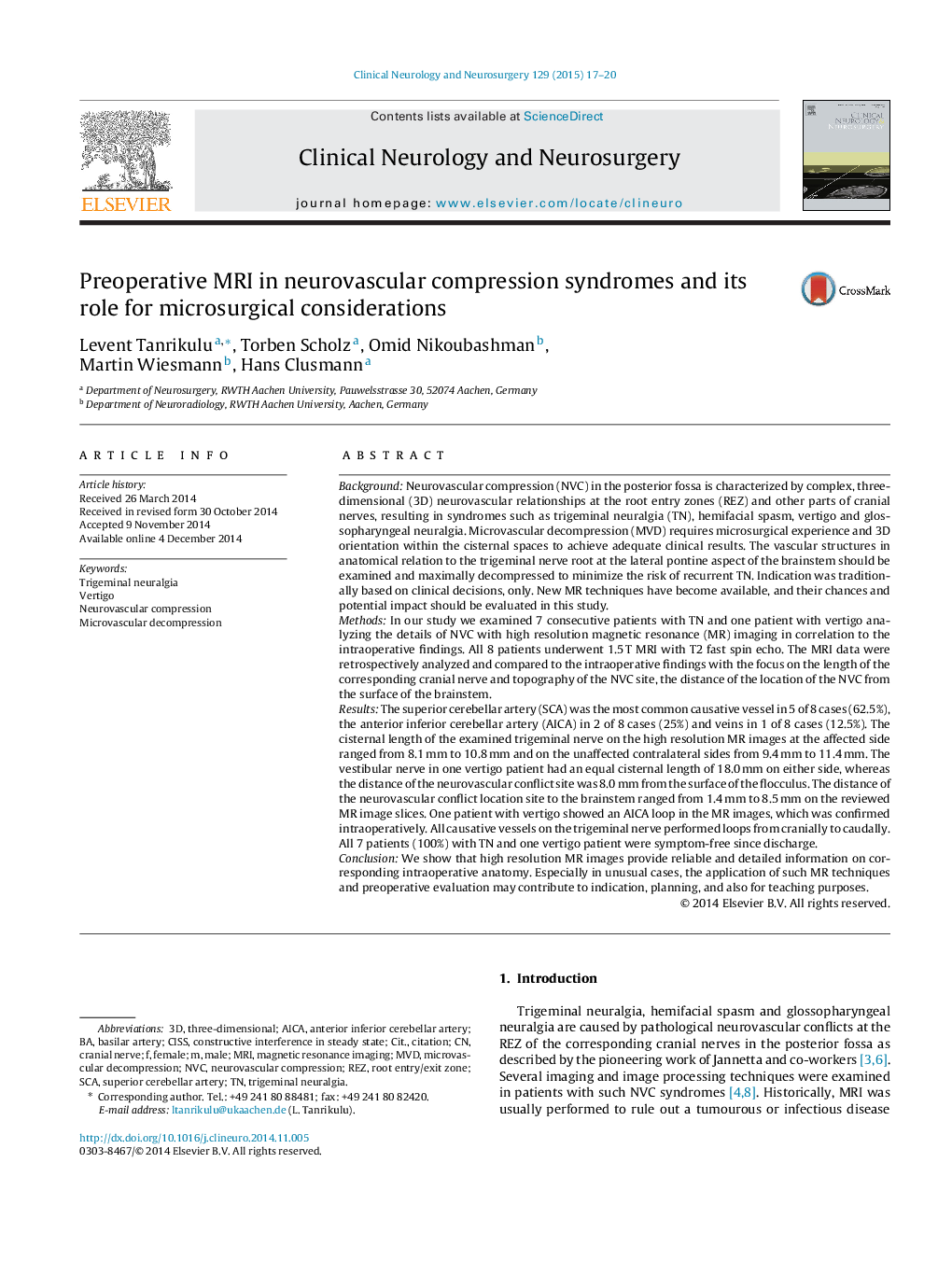| کد مقاله | کد نشریه | سال انتشار | مقاله انگلیسی | نسخه تمام متن |
|---|---|---|---|---|
| 3039971 | 1579693 | 2015 | 4 صفحه PDF | دانلود رایگان |

• We examined the validity of high-resolution MRI in the microsurgical analysis of neurovascular compression.
• We analyzed patients with trigeminal neuralgia and vertigo.
• In all patients we detected distinct courses of causative vessels in the nerve entry zones.
• High-resolution MRI provided reliable information on corresponding intraoperative anatomy, indication, planning and teaching purposes.
BackgroundNeurovascular compression (NVC) in the posterior fossa is characterized by complex, three-dimensional (3D) neurovascular relationships at the root entry zones (REZ) and other parts of cranial nerves, resulting in syndromes such as trigeminal neuralgia (TN), hemifacial spasm, vertigo and glossopharyngeal neuralgia. Microvascular decompression (MVD) requires microsurgical experience and 3D orientation within the cisternal spaces to achieve adequate clinical results. The vascular structures in anatomical relation to the trigeminal nerve root at the lateral pontine aspect of the brainstem should be examined and maximally decompressed to minimize the risk of recurrent TN. Indication was traditionally based on clinical decisions, only. New MR techniques have become available, and their chances and potential impact should be evaluated in this study.MethodsIn our study we examined 7 consecutive patients with TN and one patient with vertigo analyzing the details of NVC with high resolution magnetic resonance (MR) imaging in correlation to the intraoperative findings. All 8 patients underwent 1.5 T MRI with T2 fast spin echo. The MRI data were retrospectively analyzed and compared to the intraoperative findings with the focus on the length of the corresponding cranial nerve and topography of the NVC site, the distance of the location of the NVC from the surface of the brainstem.ResultsThe superior cerebellar artery (SCA) was the most common causative vessel in 5 of 8 cases (62.5%), the anterior inferior cerebellar artery (AICA) in 2 of 8 cases (25%) and veins in 1 of 8 cases (12.5%). The cisternal length of the examined trigeminal nerve on the high resolution MR images at the affected side ranged from 8.1 mm to 10.8 mm and on the unaffected contralateral sides from 9.4 mm to 11.4 mm. The vestibular nerve in one vertigo patient had an equal cisternal length of 18.0 mm on either side, whereas the distance of the neurovascular conflict site was 8.0 mm from the surface of the flocculus. The distance of the neurovascular conflict location site to the brainstem ranged from 1.4 mm to 8.5 mm on the reviewed MR image slices. One patient with vertigo showed an AICA loop in the MR images, which was confirmed intraoperatively. All causative vessels on the trigeminal nerve performed loops from cranially to caudally. All 7 patients (100%) with TN and one vertigo patient were symptom-free since discharge.ConclusionWe show that high resolution MR images provide reliable and detailed information on corresponding intraoperative anatomy. Especially in unusual cases, the application of such MR techniques and preoperative evaluation may contribute to indication, planning, and also for teaching purposes.
Journal: Clinical Neurology and Neurosurgery - Volume 129, February 2015, Pages 17–20